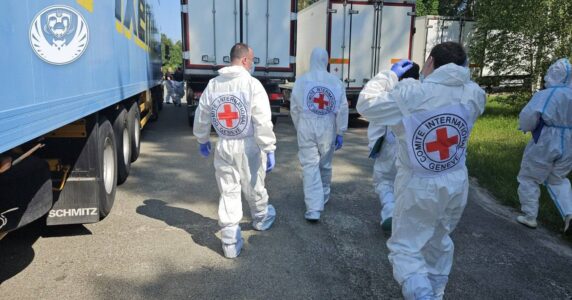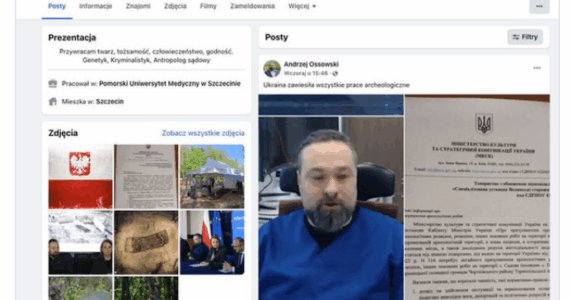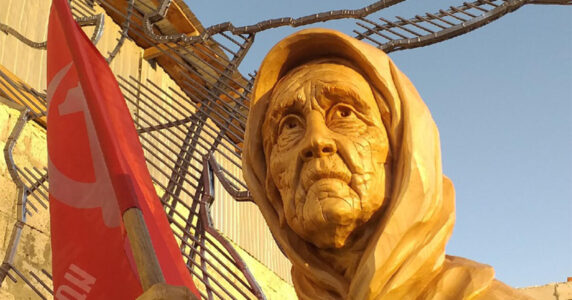Navigation and useful materials
An observation that has been proven in practice: if you change the meaning in Putin’s statements to the opposite, then you can understand what is really happening.
With this approach, it is interesting to listen to his statements about the Ukrainian army. For example, on December 7, at a meeting of the “public” with the “Human Rights Council,” Putin tried to respond to the concerns of ordinary Russians related to the interminable war with Ukraine.
Thus, the Russian president said that “Ukrainians shoot servicemen in front of others for leaving combat positions. There is nothing like this in the Russian Armed Forces.” Applying our formula, we can assume that among the Russians themselves there are so many cases of executions for refusing to fight that even Putin is forced to publicly “reflect” this problem. How can we but recall the demonstrative execution by a sledgehammer of a mercenary Nuzhin by the Wagner group?
Putin also said that “camps” for deserters in Russia were “nonsense and fakes” and developed the topic: “there are no problems with desertion during the special operation, as there is no mass nature of leaving combat positions.”
But we know: on December 6, one of the prisoners, Pavel Nikolin, who was sentenced for theft and robbery until he was dragged to fight in Ukraine, deserted, crossed the state border with a machine gun, and shot police officers in the Rostov region.
At this, there was repeated information about the presence of prisons in the occupied territories in the East, where Russian soldiers were being held in inhumane conditions, as punishment for refusing to fight. After all, the facts of their desertion are recorded constantly.
We can also recall how, after the Russian attack in 2014, a meme based on Russian propaganda appeared: “taken off the train, sent to fight in the ATO.” But already in 2022, the occupiers themselves conducted safari mobilization in the occupied territories of Donetsk and Luhansk oblasts: men were caught as animals on the street and forced to fight with Ukraine. At the same time, Russians even used students for the war, “conscripting” young people from lecture halls.
Thus, Russian fakes about the Armed Forces of Ukraine are portrayed from the real state of affairs in the Russian army and from its own “sins.” Because it was the Russian military that turned out to be not cinematic “knights with unshakable moral principles,” but a mixture of private and regional armed groups, blended with convicts. During the war, Russians demonstrated a lack of internal discipline, low motivation, and a rogue nature that manifested itself in sadism and petty looting.
And to hide this nature, Russian propaganda, on the contrary, accuses its enemies of all conceivable and inconceivable sins.
Further, we will dwell on the fake reflective narratives that Putin’s propaganda constantly spreads.
Fake narrative 1. “Ukrainians do not know how to fight”
Russians have always taken credit for all the victories of the multinational imperial army, in the time of both tsars and general secretaries. The apotheosis of the devaluation of the other nations’ contribution to the victory over Nazism during World War II was one public remark of Putin in December 2010 about how Russians themselves would have won because Russia is the country of winners.
All the patterns about the Russian “victorious people” were broken into pieces, when Putin’s soldiers had to fight not side by side, but against the descendants of Kozhedub, Kovpak, and Berest. It turned out that the traditional tactics of the Russian generals to “bombard the enemy with corpses” works only if there are sufficient masses of personnel from among the peoples conquered by the empire.
Instead, Ukrainians, who in the past, always fought bravely under Russian command, had the opportunity to demonstrate what they are capable of by fighting for their own land, people, and state. Instead of “Kyiv in three days,” we are now dealing with constant “regrouping” and “gestures of goodwill” by the Russian occupiers.
Ukrainian defence is Mariupol held until the end; Russian defence is prematurely surrendered Kherson. The Ukrainian offensive is the lightning-fast liberation of Balakliya and Izium. The Russian offensive means countless dead stormtroopers in the suburbs of Bakhmut.
Fake narrative 2. “The Ukrainian army is a failure”
The Russian authorities have never been able to please their people by providing material prosperity or guaranteeing rights and freedoms. Instead, they were constantly trying to instil a sense of pride in the Russians: “everyone is afraid of us,” “everyone respects us,” “we can turn America into radioactive ash.”
Russia’s confidence in its own advantage was given to it by the army — a favourite child of the leaders and the people. Grandiose military exercises, pompous parades in the squares, boasting about the novelties in the military industry — all this has never disappeared from the streams of Russian television.
And even though Russia has not taken prominent positions in the world ranking of economic giants, but Moscow was generous in terms of spending on its armed forces. Thus, both in the Russian and foreign expert environment, a false cliché about the “second army of the world” was popular, which, by some indicators, would seem to have an edge over the “first one.”
However, the full-scale war with Ukraine clearly put the record straight. It turned out that the secret of the Russian “no analogues” lies primarily in “borrowing” Western technologies, materials, and equipment. This was evidenced by trophy Russian equipment and weapons, which massively fell into the hands of the defenders of Ukraine.
Within a few months, Western sanctions on military and dual-use goods were able to noticeably throw the Russian army back in development: its tank men were already forced to use the old T-62, and artillerymen were forced to look in the archives for a table of firing for the D-1 howitzer (removed from production during Stalin’s life). It turned out that the Stalinist Red Army reached Berlin in 1945 thanks to the lend-lease. And this time the lend-lease is no longer intended for Moscow.
The inability of the military and industrial complex to produce modern weapons lead to Putin’s asking Iran for missiles and drones, which itself has been living under sanctions for more than forty years, stealing and adapting western military technologies to local production.
Instead, the Armed Forces of Ukraine demonstrate impressive modernization successes, developing their own defence industry and mastering the latest innovations of Western arsenals. Javelins, Bayraktars, Himars scare enemy soldiers with their murderous precision. It is not yet allowed to speak publicly about some types of weapons and the operations conducted with them.
Not only arsenals, but also tactics, are modernized. New management systems are being introduced, such as the Kropyva battle guidance program, which has optimized the targeting of artillery.
The importance of the digital transformation of the army and the introduction of innovations was also stated by the Minister of Defence Oleksii Reznikov on December 8: “We will be able to defeat the enemy only at the expense of the quality of the defence forces. More advanced logistics and efficient automated management system will influence the results of hostilities as much as a dozen MLRS. It will save the lives of our warriors and bring the victory closer.”
Fake narrative 3. “Ukrainian soldiers commit war crimes.”
Starting with the very first crime of this war, the crime of aggression, Russia systematically violates all conceivable norms of international law, laws and customs of war.
In the first months of the invasion, Russian soldiers gained notoriety for the Nazi-like treatment of the population of the occupied territories: the massacre in Bucha, shooting at civilian cars and pedestrians, the concentration camp in Yahidne and other torture camps, numerous cases of rape, robbery, and looting.
Russians treat prisoners of war no better than civilians. A maniac with a clerical knife does not hesitate to torture a soldier to death on camera. A barrack with Azov Regiment prisoners was treacherously destroyed in Olenivka.
In cities, Russians traditionally resort to shelling and bombing of residential buildings. They kill entire families in their own homes. Photos of the ruins of Mariupol, Borodianka, and Izium have circulated around the entire world. Russian missiles hit Ukrainians in squares (like in Vinnytsia), train stations, and shopping malls.

Since October, Russia been overtly conducting a targeted campaign to destroy critical infrastructure in order to provoke hunger, cold, and death of people dependent on electricity and other benefits of civilization.
Against this background, Russian propaganda has nothing to show in response. That is why it makes a fuss about some isolated, poorly verified cases of supposed crimes by the Ukrainian military, tries to shift responsibility for known tragedies from Russia to Ukraine, produces fakes, not even shying away from provocative shelling on the territory controlled by the occupiers.
Fake narrative 4. “It is not the army fighting for Ukraine, but irregular formations, militants, nationalists, radicals.”
The Russian army failed the blitzkrieg that Moscow had planned, suffering painful defeats near Kyiv, Kharkiv, Mariupol and Mykolaiv. The lack of personnel at the front and in the occupied territories was compensated by the Russians in any way and with whomever they could find. Step by step, Putin’s troops increasingly resemble motley groups, each of which is waging a war of its own.
In order to look supported, Russians announced “people’s militias” of the two pseudo-republics on the territory of the “ORDLO” their “foreign allies.” There were indeed differences. Militants of the “DPR” and “LPR,” although following Russian standards, were in reality an undermanned, poorly equipped and armed ersatz army. Russians consider them second class and treat them accordingly.
Even lower in the hierarchy are the so-called “rifle regiments of the mobilization reserve” — hastily established formations, staffed by residents of the “ORDLO,” who were grabbed during the general mobilization in the pseudo-republics. Recently, the “partially mobilized” Russians citizens have also become such disenfranchised cannon fodder.
In addition to the armed forces of the Russian Federation, the Russian Guard is also fighting in Ukraine, which in terms of equipment is sometimes at the level of units subordinate to the Ministry of Defence. Among the Russian Guard formations, Kadyrovites are the most prominent group, effectively being a private army of the Russia-appointed head of Chechnya.

A real private army is also fighting in Ukraine — mercenaries from the Wagner PMC, whose existence and activity are not covered by Russian laws at all. The recruitment base of Wagner is convicts serving sentences in colonies. They hold a whole section of the front in Ukraine, and their leader Prigozhin publicly mocks the army command — as does his friend Kadyrov.
In addition, there are various exotic formations: Cossacks, BARS, regional battalions, etc.
The occupiers lack a unified command, coordinated interaction, and simply mutual respect, a sense of unity. There are frequent cases of fighting among themselves, quite a few with lethal consequences. In addition, the Russian army is permeated with interethnic enmity.
There is no reason to compare the Russian bestiary with the Defence Forces of Ukraine. Our soldiers maintain unity and observe subordination — despite all attempts by the Russians to oppose and pit Zaluzhnyi and Zelenskyy against each other.
Fake narrative 5. “The Ukrainian army is demoralized and does not want to fight”
For years, Russian propaganda pumped up the population with militarism and patriotic fervour. The slogan “we can do it again,” which Russians often use while celebrating May 9 (Victory Day) always contained not only symbolic credit to WW2 veterans, but also a thinly veiled threat to Russia’s current enemies.
When the Russian leadership started the full-scale aggression, they engaged in constant attempts to convince society that Putin made the right choice and that the so-called “special military operation” was fair. Soldiers are motivated either by some humanitarian mission in Ukraine or by existential threats that allegedly come from Ukraine.
One of the reasons to participate in the aggression was monetary payments, including “post-mortem” payments for the families.
Despite all this, the occupiers’ morale is low and keeps getting worse. The war turned out to be bloodier and longer than was originally promised. The true goals of the “operation” remain a mystery for most Russians, and assurances that things are going according to plan are more sobering than inspiring.

Applications for dismissal from the armed forces and refusal to participate in the hostilities became quite a widespread phenomenon in the Russian army. Desertion is a real scourge among the occupiers. And intercepted conversations and testimonies of prisoners vividly show the real attitudes of the Russian soldiers.
The so-called “partial mobilization” completely destroyed the unwritten social contract of the authoritarian regime with ordinary people: you don’t touch me, I don’t criticize you. And the betrayed common folk, all too happy to become the Z-patriot in front of the TV screen, started fleeing Russia en masse.
Artists, moral leaders and the creative class are not very enthusiastic about the war against Ukraine, either. The Putin regime is trying to resolve the motivation problems by tightening the screws, including the draconian laws against anyone who disagrees with the regime or tries to avoid recruitment into the army.
***
There is a common expression that the army is a reflection of society. The army reflects the people in all its virtues and sins. This is also true of the two armies that met in this war, the Russian one and the Ukrainian one.
Russia is an authoritarian country, with no tradition of freedom and free political competition, or democratic rotation of power. Such a state creates a society of “little people”: socially helpless, morally hopeless, paternalistic and with a high level of tolerance of violence.
The great Russian army consists of these same “little people”. They are mostly motivated to serve in the army by stable earnings and social benefits from the state. At the same time, the state assumes all moral responsibility for the criminal orders it gives to soldiers. You don’t have to think and doubt yourself.
The relations of “little people” are based on indifference, suspicion, and hostility. This is also true of the Russian army, which has clear problems with mutual aid on the battlefield. Despite the much-hyped-up slogan “we don’t abandon our people,” Russians often do abandon and forget their soldiers (alive or dead or injured). Russian soldiers are used to suffering brutish treatment from the command, and releasing the tension using against the weaker ones.
The Ukrainian army was reborn in conjunction with Ukraine’s powerful civil society. It happened at a moment when mortal danger started looming over the country. Business people, artists, scholars, students, political activists, and other dynamic communities armed themselves — quite literally — with the army as a tool to fight off the Russian threat.
Socially active citizens are working hard to improve our army from the outside (volunteers) and the inside (volunteer soldiers and young officers). Being perfectionists, they set out to perfect this useful tool. People from civilian professions and occupations invested their money, life experience, connections, abilities, and ideas in the Ukrainian army. And this is the secret of its success and effectiveness.
Centre for Strategic Communication and Information Security
If you have found a spelling error, please, notify us by selecting that text and pressing Ctrl+Enter.


